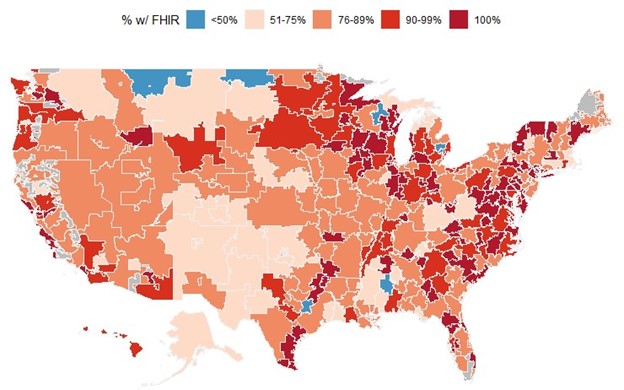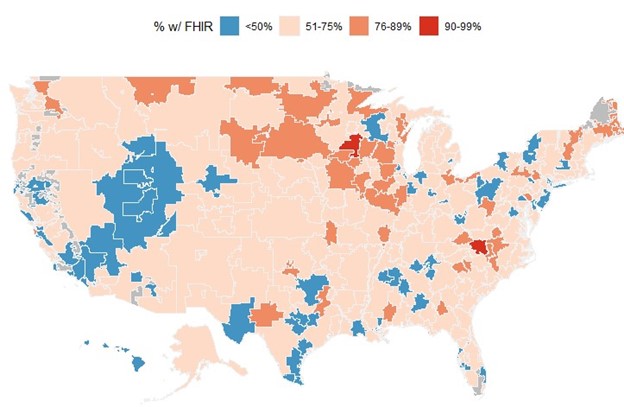The Heat is On: US Caught FHIR in 2019
Steven Posnack and Wes Barker | July 29, 2021
In 2018, the United States was at a turning point with respect to the adoption and implementation of the Health Level Seven (HL7®) Fast Healthcare Interoperability Resources (FHIR®) standard in health information technology (health IT). At that time, our analysis, outlined in a previous blog post predicted that the U.S. could soon see widespread adoption of certified application programming interface (API) technology enabled with FHIR. The results are in, and the findings are encouraging.
The US is Catching FHIR
In 2018, we estimated that 87% of hospitals and 69% of clinicians possessed certified technology with a 2015 Edition version enabled with FHIR. These rates were not a prediction of who would adopt FHIR-enabled technology in 2019, but instead served as an estimated upper bound of who could upgrade their certified technology to a 2015 Edition version enabled with FHIR in 2019. Today, new analysis shows that the rates of observed technology adoption came very close to these estimates.
As of 2019, 84% of hospitals and 61% of clinicians adopted and implemented 2015 Edition certified API technology enabled with FHIR (see Table 1). We found that 97% of hospitals and 88% of clinicians whom we predicted in 2018 could adopt this technology did so in 2019.
Table 1: Percent of hospitals and clinicians that adopted or could adopt (but did not) 2015 Edition certified API technology enabled with FHIR, 2019
| % adopted | % could adopt (but did not)3 |
% adopted or could adopt |
|
| Hospitals1 | 84% | 7% | 91% |
| Clinicians2 | 61% | 11% | 72% |
Notes: (1) All U.S. non-federal acute care hospitals. (2) All Merit-based Incentive Payment System (MIPS) eligible clinician types. (3) Could adopt represents the percentage of hospitals and clinicians who have not adopted 2015 Edition technology but possess certified technology with a 2015 Edition version enabled with FHIR.
Moreover, we found that 91% of hospitals and 72% of clinicians have adopted or could adopt 2015 Edition certified technology enabled with FHIR, a small increase from the 2018 estimate. This means, in addition to those hospitals and clinicians that adopted technology in 2019, another 7% of hospitals and 11% of clinicians could upgrade to 2015 Edition certified technology enabled with FHIR from their current health IT developer.
Similar to prior analysis, technology adoption from market leading developers comprises most of this trend. Table 2 shows that 83% of hospitals and 58% of clinicians adopted certified API technology from a market leader in 2019. This represented 99% and 95% of all FHIR-enabled technology deployments respectively. The findings show that health IT market leaders, who all support FHIR, drove much of the adoption of certified API technology enabled with FHIR in 2019.
Table 2: Percent of hospitals and clinicians that adopted and implemented certified API technology from market leaders (all support FHIR), 2019
| developer | % hospitals | % clinicians |
| Allscripts | 5% | 3% |
| athenahealth | 2% | 7% |
| Cerner Corporation | 20% | 5% |
| CPSI | 6% | <1% |
| eClinicalWorks | — | 5% |
| Epic Systems Corporation | 32% | 35% |
| MEDHOST | 3% | <1% |
| MEDITECH | 15% | 1% |
| NextGen | — | 2% |
| All market leaders | 83% | 58% |
Mapping Deployments
The following maps show that adoption of technology enabled with FHIR is widespread across the US. However, looking beyond these national estimates, we observed geographic variation in deployments across the US.
Figure 1 shows that hospitals in most regions are at or above the national 84% average with some regions showing that 100% of hospitals have deployed technology enabled with FHIR. It’s important to note that hospitals in some regions lag behind, such as in the southwest and mountain west.
Figure 1: Percent of all hospitals that adopted and implemented certified API technology enabled with FHIR in 2019, by healthcare referral region (HRR)
Notes: Map depicts borders of healthcare referral regions (HRRs). Gray areas are regions without known hospitals.
Figure 2, focused on clinicians, shows a similar story, though one of far less widespread adoption than hospitals (as the national averages show as well). However, most regions are performing on average with some variation in certain regions, particularly in the mountain west.
Figure 2: Percent of all clinicians who adopted and implemented certified API technology enabled with FHIR in 2019, by healthcare referral region (HRR)
Notes: Map depicts borders of healthcare referral regions (HRRs). Gray areas are regions without known clinicians.
The Trend is Expected to Continue
The 2020 ONC Cures Act Final Rule requires use of FHIR Release 4 as part of the new certification criterion adopted at 45 CFR 170.315(g)(10), Standardized API for Patient and Population Services. Also, as required by the API Condition and Maintenance of Certification at 45 CFR 170.404(b)(3), software developers with health IT previously certified for technical API conformance must provide all customers with upgraded API technology certified to this new certification criterion by no later than December 31, 2022.[1-2] The good news is that while upgrades from FHIR Release 2 to Release 4 are likely to be necessary across many installations, many certified API developers and all health IT market leaders already support the FHIR standard.
The data show that, as of 2019, most – 84% of hospitals and 61% of clinicians – adopted and implemented certified API technology enabled with FHIR. This means that third-party developers are able to connect to these providers’ EHRs using standardized FHIR APIs and health information can flow using the data standard. Not all providers adopted and implemented certified API technology enabled with FHIR in 2019, but, for those who did, the results are encouraging.
We expect these rates to increase as more hospitals and clinicians adopt and implement the 2015 Edition Cures Update and more certified API developers move toward support of the FHIR standard. The data show that a majority of health care providers have deployed these standards-based technologies, and we project that more will soon follow. Efforts to expand use of FHIR among data and technology users should be encouraged by this data.
[1] 21st Century Cures Act: Interoperability, Information Blocking, and the ONC Health IT Certification Program. 85 FR 25642. https://www.federalregister.gov/documents/2020/05/01/2020-07419/21st-century-cures-act-interoperability-information-blocking-and-the-onc-health-it-certification. Accessed: February 19, 2021.
[2] Information Blocking and the ONC Health IT Certification Program: Extension of Compliance Dates and Timeframes in Response to the COVID-19 Public Health Emergency. 85 FR 70064. https://www.federalregister.gov/documents/2020/11/04/2020-24376/information-blocking-and-the-onc-health-it-certification-program-extension-of-compliance-dates-and. Accessed: July 27, 2021.
—
Data:
FHIR adoption rates for clinicians and hospitals by HRR are available in this public dataset
Notes:
Data Sources: 2019 Medicare Promoting Interoperability Program data; ONC Certified Health IT Product List (CHPL); Centers for Medicare & Medicaid Services’ Provider of Services file; Doctors and Clinicians National Downloadable File.
Methods: In 2019, the Medicare Promoting Interoperability (PI) Program required the use of 2015 Edition certified EHR technology by hospital and clinician participants for the first time. This technology included certified APIs, also, for the first time. We cross matched 2015 Edition certified health IT module listings in the Certified Health IT Product List (CHPL) to the certified EHR technology reported by hospital and clinician PI Program participants in 2019. An analysis of certified API technology documentation available through the CHPL confirmed a certified module’s support for FHIR. We, therefore, used officially reported certified technology data from 2019 to verify technology adoption and API documentation data from the CHPL to confirm FHIR support among the reported certified technology. The data, therefore, may under-represent actual adoption of certified API technology not reported officially through the PI Program.
For the original 2018 blog, we analyzed the 2015 Edition certified health IT module listings in the CHPL and hospital and clinician certified technology adoption data, before the start of the 2019 PI Program Year, to model likely deployment of FHIR-based APIs among these health care providers. This was a prospective analysis that sought to model how requirements to adopt 2015 Edition certified API technology might be realized in 2019. Now, using 2019 PI Program data and an updated analysis of the API documentation available through the CHPL, we can quantify the percent of hospitals and clinicians that deployed and reported using certified technology enabled with FHIR-based APIs in 2019.
Definitions:
Hospitals: All US non-federal acute care hospitals.
Clinicians: All US Medicare-enrolled, Merit-based Incentive Payment System eligible clinician types.
Technology enabled with FHIR: Certified health IT modules that reference the FHIR standard as part of their official API documentation associated with their health IT certificate discoverable in the CHPL.




